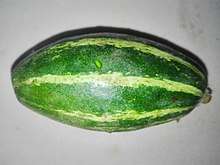Trichosanthes dioica
Trichosanthes dioica, also known as pointed gourd,[1] is a vine plant in the family Cucurbitaceae, similar to cucumber and squash, though unlike those it is perennial. It is a dioecious (male and female plants) vine (creeper) plant with heart-shaped leaves (cordate) and is grown on a trellis. The fruits are green with white or no stripes. Size can vary from small and round to thick and long — 2 to 6 inches (5 to 15 cm). It thrives well under a hot to moderately warm and humid climate. The plant remains dormant during the winter season and prefers a fertile, well-drained sandy loam soil due to its susceptibility to water-logging.
| Trichosanthes dioica | |
|---|---|
 | |
| gourd | |
| gourd plants Raihan | |
| Scientific classification | |
| Kingdom: | Plantae |
| Clade: | Tracheophytes |
| Clade: | Angiosperms |
| Clade: | Eudicots |
| Clade: | Rosids |
| Order: | Cucurbitales |
| Family: | Cucurbitaceae |
| Genus: | Trichosanthes |
| Species: | T. dioica |
| Binomial name | |
| Trichosanthes dioica | |
.jpg)
Vernacular names
Trichosanthes dioica is known as
- parwal or parval or पर्वल in Nepali, Hindi and Gujarati
- parbal or ਪਰਬਲ or پربل in Punjabi
- kambupudalai in Tamil[2]
- potals in Telugu (especially in Northeastern Andhra)
- കാട്ടുപടവലം (Kāttu Padavalam) in Malayalam
- potol in Bengali (pôţol) and Assamese
- potala in Odia
- paror in Maithili
- parol in Magahi
- patall or پٹل in Bhojpuri, Urdu and Awadh
India
Colloquially, in India, it is called parval or green potato. It is widely cultivated in the eastern and some northern parts of India, particularly in North eastern Andhra, Odisha, Bengal, Assam, Bihar, and Uttar Pradesh. It is used as an ingredient for soup, stew, curry, sweet, or eaten fried and as potoler dorma or dolma (dolma) with fish, roe or meat stuffing. Parval is also used to make Kalonji, a deep fried cuisine filled with spices.
Bangladesh and West Bengal
Pointed gourd is provincially known as potol in both of these Bengali-speaking regions. It is a vital summer vegetable in Bangladesh and in West Bengal. It is cultivated and consumed in every part of Bangladesh and West Bengal. It is a perennial crop and sold at the end of October when there is a shortage of other alternative vegetables.[3]
Nutrients
Pointed gourd is a good source of vitamins and minerals. It is a good source of carbohydrates, vitamin A, and vitamin C. It also contains major nutrients and trace elements (magnesium, potassium, copper, sulfur, and chlorine) which are needed in small quantities, for playing essential roles in human physiology. 9.0 mg Mg, 2.6 mg Na, 83.0 mg K, 1.1 mg Cu and 17 mg S per 100 g edible part.[3]
In human culture
The fifteenth-century Hatha Yoga Pradipika 1.61-65 recommends Parwal as one of the foods suitable for yogins.[4]
See also
References
| Wikimedia Commons has media related to Trichosanthes dioica. |
- "Trichosanthes dioica". Germplasm Resources Information Network (GRIN). Agricultural Research Service (ARS), United States Department of Agriculture (USDA). Retrieved 27 September 2015.
- Pointed Gourd Health Benefits, Usage – Ayurveda Details
- Khatun, M; Malek, M. A.; Bari Miah, M. A.; Al-Amin, M.; Khanam, D. "In Vitro Regeneration In Pointed Gourd" (PDF). Bangladesh Research. Bangladesh Agricultural University. Retrieved 30 May 2015.
- Bernard, Theos (2007) [1950]. Hatha yoga : the report of a personal experience. Edinburgh: Harmony. pp. 92–93. ISBN 978-0-9552412-2-2. OCLC 230987898.
External links
- Article about parwal from Fort Valley State University College of Agriculture